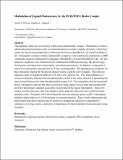Modulation of ligand fluorescence by the Pt(II)/Pt(IV) redox couple
Author(s)
Wilson, Justin Jeff; Lippard, Stephen J.
DownloadFinalRevisedMs-4.pdf (1.760Mb)
PUBLISHER_CC
Publisher with Creative Commons License
Creative Commons Attribution
Terms of use
Metadata
Show full item recordAbstract
The dangling carboxylic acid moiety of the known platinum(II) complex, [Pt(edma)Cl2] (edma = ethylenediaminemonoacetic acid), was functionalized via amide coupling chemistry with benzyl amine and dansyl ethylenediamine to afford the derivatives [Pt(edBz)Cl2] (1) and [Pt(edDs)Cl2] (2). Subsequent oxidation of these platinum(II) complexes with iodobenzene dichloride in DMF yielded the respective platinum(IV) analogs, [Pt(edBz)Cl4] (3) and [Pt(edDs)Cl4] (4). All four platinum complexes were characterized by multinuclear NMR spectroscopy, IR spectroscopy, electrospray ionization mass spectrometry, and elemental analysis. In addition, compounds 1 and 3 were structurally characterized by X-ray crystallography. The photophysical properties of the compounds bearing the fluorescent dansyl moiety, 2 and 4, were evaluated. The emission quantum yields of 2 and 4 in DMF are 27% and 1.6%, respectively. This large difference in emission efficiency indicates that the platinum(IV) center in 4 is more effective at quenching the dansyl-based fluorescence than the platinum(II) center in 2. Time-dependent density functional theory calculations indicate that 4 has several low-lying singlet excited states that energetically lie below the primary radiation-accessible excited state of the dansyl fluorophore. These low-energy excited states may offer non-radiative decay pathways that lower the overall emission quantum yield. Treatment of 4 with biologically relevant reducing agents in pH 7.4 phosphate-buffered saline induces a 6.3-fold increase in emission intensity. These results demonstrate that 4 and future derivatives thereof may be useful for imaging the reduction of platinum(IV) complexes in living systems, chemistry of importance for evolving platinum-based anticancer drug strategies.
Description
Dedicated to Professor Jon Zubieta on the occasion of his 65th birthday.
Date issued
2012-01Department
Massachusetts Institute of Technology. Department of ChemistryJournal
Inorganica Chimica Acta
Publisher
Elsevier
Citation
Wilson, Justin J., and Stephen J. Lippard. “Modulation of Ligand Fluorescence by the Pt(II)/Pt(IV) Redox Couple.” Inorganica Chimica Acta 389 (July 2012): 77-84.
Version: Author's final manuscript
ISSN
00201693